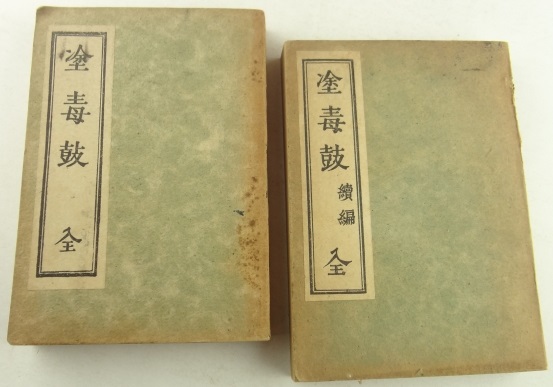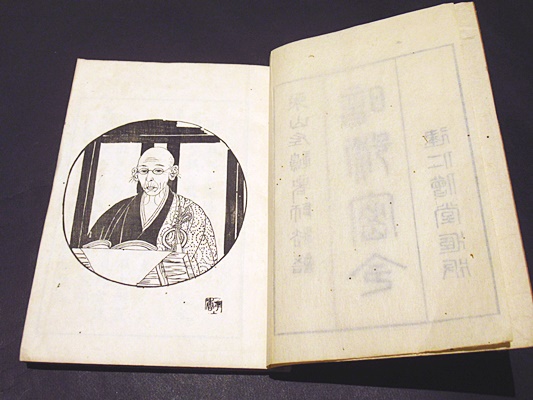ZEN MESTEREK ZEN MASTERS
« Zen főoldal
« vissza a Terebess Online nyitólapjára

『塗毒鼓』
Zudokko
compiled by 藤田玄路 Fujita Genro (1880-1935)

Fujita Genro, compiler. Zudokko (Drum Smeared with Poison), 2 vols. Kyoto: Kenninji Sodo. 1922.
Zudokko kushū (Poison Painted Drum Phrase Collection).
The Zudokko (Poison Painted Drum) is a two-volume Zen monk’s handbook compiled
by Fujita Genro (1880–1935), a layman who trained under Takeda Mokurai
Rōshi of the Kenninji monastery in Kyoto. Though a small-format handbook,
the Zudokko is an enormous resource containing almost all the documents
necessary for Rinzai practice: all the major kōan collections including the Hekiganroku,
the Mumonkan, the Kattōshū (Tangled Vine Collection), and the
Chin’ushū (Collection of Poisonous Wings); the entire kanji text of the Rinzai roku
and the Kidō Daibetsugo (The Alternate Phrases of Kidō Oshō, an advanced kōan
text); excerpts from the records of the Zen Patriarchs and from Hakuin’s writings;
and many other Zen documents. The Zudokko was originally published
by Kenninji monastery. Fujita’s Afterword to the second volume is dated Taishō
11 (1922), which will be taken here as its year of publication. The title—Zudokko
(Poison Painted Drum)—symbolizes the effects on learners of these Zen teachings.
The skin of the drum of Zen is painted with a virulent poison taken from
the wing of the poison blackbird; when the drum is beaten, all who hear it die.Fujita Genro was born Fujita Tokujirō in 1880 in Naniwa, Osaka Prefecture,
and from an early age showed a strong interest in Buddhism. After graduating
from high school, he made his way to Kyoto, where in 1900 he came
into contact with Takeda Mokurai Rōshi. He left Japan in 1905 to study at New
York University as a foreign student and returned to Japan in 1908 (ZGDJT
1073c; Obata 1938 624–626). He was part of a successful business family
which is still active in commerce and arts today. His layman’s name, Genro,
conferred by Takeda Mokurai Rōshi, is probably taken from the line in the
Nandō benken jūmon (Nandō’s Ten Examination Gates), “You must go by the
dark path [genro] of the flying bird,” Subekaraku chōdō no genro o yukubeshi (in
vol. 2 of Zudokko). The dark path is the path of one who leaves no traces, just
as a bird leaves no traces in its path of flight. The two Afterwords which he
wrote for the two volumes of the Zudokko are written in lines of 4-character
verse in the so-called “horse-hoof style” (bateikei, because a galloping horse
leaves hoofprints in series of four), probably in a deliberate imitation of the
style of the opening preface to the Rinzai roku. They make numerous allusions
to the Chinese classics and display the self-effacing ironic style of Zen writing.
They show that Genro had progressed to quite an advanced stage of kōan
practice and that he was also a serious scholar of the Chinese classics.At the end of the second volume of the Zudokko is a section entitled simply
Kushū, “Phrase Collection.” This collection contains 2,397 phrases categorized
according to the number of characters. Only the characters are printed. No
kanbun margin symbols are provided; no readings are given; there is no commentary
providing citation of source or explanation of meaning. As Takeda
Mokurai says in the Foreword to the second volume, “Companion on the way,
layman Genro is the author of the Poison Painted Drum. He has snatched up
the many poisons of our school and flung them at the faces of people. He gives
no reading for any character; he gives no annotation for any phrase. He does
this out of the goodness of his grandmotherly heart.” Some Zen priests argue
that the Zudokko kushū is thus the best text to use in searching for jakugo, since
one confronts the bare kanji without the interference of margin symbols and
annotation. But practitioners consider the Zudokko kushū hard to use for the
same reasons—it does not provide these aids to assist the reader.
(G. Victor Sōgen Hori)